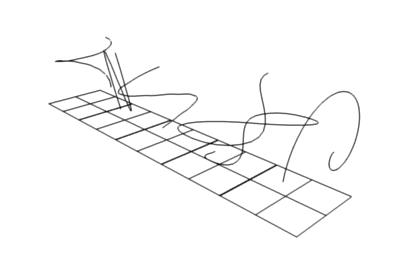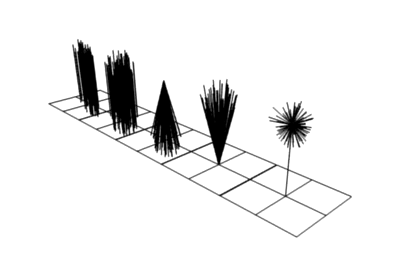Потомки (children)¶
Ссылка
- Панель:
Потомки – это частицы «волос» или «источника», возникающие из отдельных частиц. Они позволяют работать преимущественно с относительно небольшим количеством родительских частиц, для которых рассчитывается физика. Затем потомки присоединяются к своим родителям. Количество и визуализацию потомков можно менять без пересчёта физики.
Если вы активируете потомков – родители отображаться больше не будут. Это можно включить на панели «рендеринга» – «родительские частицы». По умолчанию родительские частицы не визуализируются, поскольку форма дочерних частиц может сильно отличаться от формы их родителей.
Общие параметры¶
- Тип потомков
- Нет (none)
Потомки не создаются.
- Простой (simple)
Потомки распространяются из родительской позиции.
- С интерполяцией (interpolated)
Потомки создаются между родительскими частицами на гранях меша. Они интерполируются между соседними родительскими элементами. Это очень удобно при работе с мехом, поскольку можно добиться равномерного распределения. Некоторые из потомков могут стать виртуальными родителями, влияющими на другие частицы поблизости.
- Количество в предпросмотре (display amount)
Отображаемое количество потомков в 3D-вьюпорте.
- Количество на рендере (render amount)
Количество потомков для рендеринга.
- Длина (length)
Длина путей потомков.
- Порог (threshold)
Количество частиц, оставшихся нетронутыми длиной пути потомка.
- Вариация (seed)
Смещение в таблице случайных чисел для дочерних частиц, чтобы получить другой вариативный результат.
Скопление (сlumping)¶
Ссылка
- Панель:
- Использовать кривую скопления (use clump curve)
Использовать виджет кривых вместо параметров.
- Скопление (clump)
Размер скопления вдоль дочерних прядей. Потомки могут встретиться на кончике (1.0) или начать вместе у корня (-1.0).
- Форма (shape)
Форма скопления. Либо обратная парабола (0.99), либо экспоненциально (-0.99).
- Скручивание (twist)
План
В процессе добавления.
- Использовать кривую кручения (use twist curve)
План
В процессе добавления.
Шум скопления (clump noise)¶
Создаёт случайные скопления вокруг родительских волос.
- Величина шума скопления (clump noise size)
Размер скоплений.
Шероховатость (roughness)¶
Ссылка
- Панель:
- Использовать кривую шероховатости (use roughness curve)
Использовать виджет кривых вместо параметров.
- Однородная, размер (uniform, size)
Основаны на местоположении потомков, поэтому варьируют пути аналогичным образом, когда потомки находятся рядом.
- Конечная точка, форма (endpoint, shape)
«Грубый конец» рандомизирует концы пути (что-то вроде случайного отрицательного скопления). Форма может варьироваться от <1 (параболическая) до 10.0 (гиперболическая).
- Случайно, размер, порог (random, size, threshold)
Основаны на случайном векторе, поэтому не одинаковы для ближайших потомков. Порог можно настраивать, чтобы применить его только к части дочерних элементов. Это полезно для создания отдельных (заблудших) потомков, которые не будут делать то, что делают другие.
Изгиб (kink)¶
Ссылка
- Панель:

Потомки с изгибом.¶
Слева направо: завиток, радиальный, волна, оплётка, спираль.
С помощью изгиба вы можете вращать потомков вокруг родителя. См. рис. Потомки с изгибом. выше, чтобы увидеть различные типы изгиба.
- Тип изгиба
- Ничего (nothing)
Деактивирован.
- Завиток (curl)
Потомки растут по спирали вокруг родительских волосков.
- Радиально (radial)
Потомки формируют вокруг родителя волновую форму, проходящую через родительские волосы.
- Волна (wave)
Потомки образуют волну, все в одном направлении.
- Оплётка (braid)
Потомки заплетаются вокруг волос родителей.
- Спираль (spiral)
Создаёт спираль на конце каждого волоса.
- Радиус, разрешение (radius, resolution)
Определить общий размер.
- Форма (shape)
Заставляет спираль расти внутрь или наружу.
Примечание
Ограничения для выравнивания
Когда волосы направлены прямо вверх (вдоль выбранной оси спирали, по умолчанию Z), спирали могут не отображаться! Это ограничение используемого метода проецирования. Исправляется небольшим наклоном или случайной ориентацией волос.
- Амплитуда (amplitude)
Амплитуда смещения.
- Скопление (clump)
Насколько сильно скопление влияет на амплитуду излома.
- Спрямлённость (flatness)
Насколько выпрямлены волосы.
- Частота (frequency)
Частота смещения (1/общая длина). Чем выше частота, тем больше делается вращений.
- Форма (shape)
Где начинается вращение (смещение вращения).
Простой (simple)¶
- Размер (size)
Множитель для размера потомков.
- Случайный размер (random size)
Случайная вариация размеров дочерних частиц.
- Радиус (radius)
Радиус, в котором потомки распределяются вокруг своих родителей. Это 3D, поэтому потомки могут быть выше или ниже, чем их родители.
- Округлость (roundness)
Округлость потомков вокруг родителей. Либо в сфере (1.0), либо в плоскости (0.0).
С интерполяцией (interpolated)¶
- Виртуальные родители (virtual parents)
Относительное количество виртуальных родителей.
- Длинные волосы (long hair)
Рассчитывать потомков наилучшего соответствия длинным волосам.
Расщепление (parting)¶
- Расщепление (parting)
Создаёт пробор у дочерних прядей на основе родительских.
- Мин/Макс
Минимальный/максимальный угол от корня до кончика (расстояние от кончика/расстояние от корня – для длинных волос).
Пример¶

Слева направо: округлость: 0.0, округлость: 1.0, скопление: 1.0, скопление: -1.0, форма: -0.99.¶